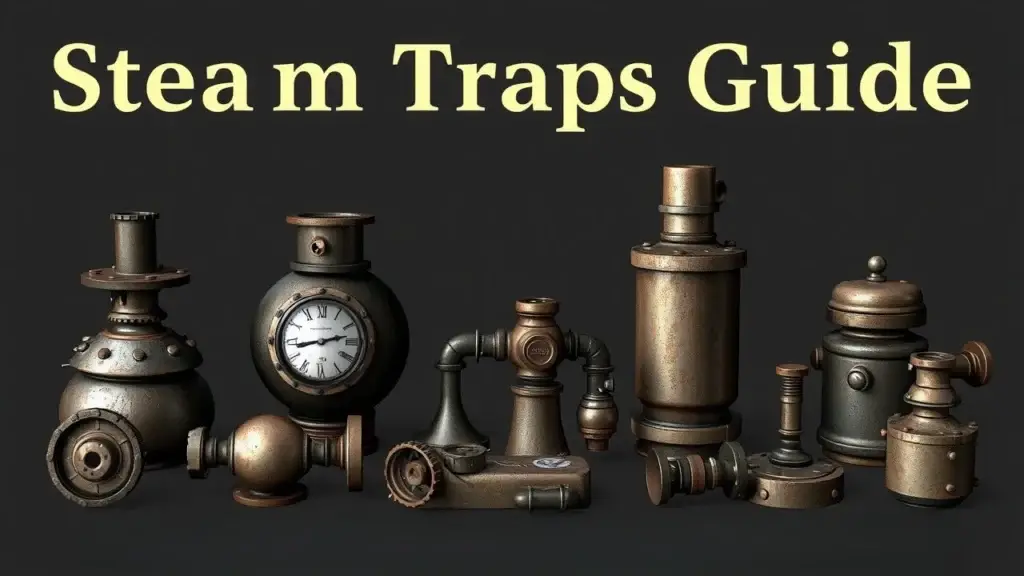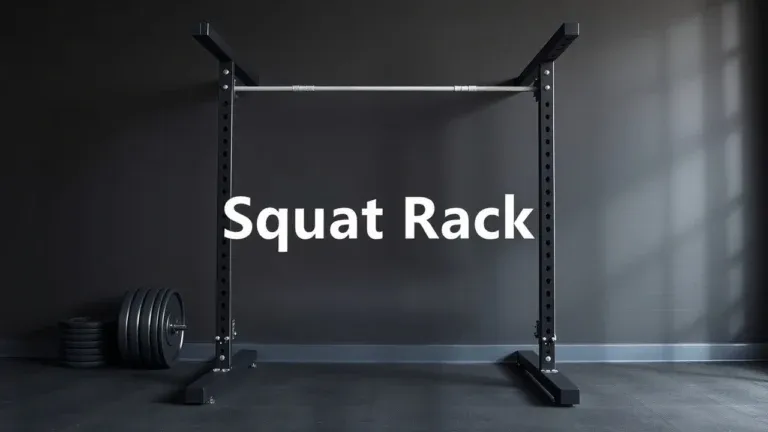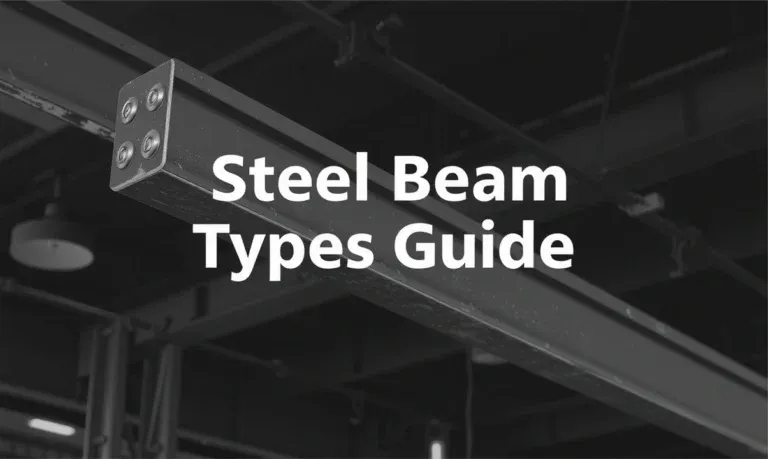This guide explains various types of steam traps, including thermostatic and balanced pressure traps, crucial for efficient condensate removal. Proper selection and maintenance optimize steam system performance and prevent damage.
What Are Steam Traps and Why Are They Important?

Steam traps are key components in industrial steam systems. They act as automatic valves that remove condensate while keeping live steam inside. This function is crucial for maintaining energy efficiency and ensuring heating systems run reliably. By effectively managing condensate removal, steam traps help optimize thermal efficiency, reduce energy waste, and boost overall plant productivity.
Choosing the right type of steam trap is very important. If you pick the wrong one, it can lead to serious issues like energy loss, equipment damage from water hammer, or flooding. This can raise operational costs over time. Knowing the benefits of different types of steam traps helps maintenance engineers and plant operators make better decisions that improve system reliability.
Benefits of Steam Traps
- Energy Savings: When steam traps work well, they reduce heat loss by allowing only condensate to escape and keeping valuable live steam.
- Improving Plant Efficiency: Good condensate management enhances thermal performance in various processes.
- Reducing Energy Waste: By stopping unnecessary venting of live steam, plants can cut their fuel consumption significantly.
Effective use of steam traps not only saves energy but also supports a facility’s financial health by enhancing operational efficiency.
Overview of the Main Types of Steam Traps
Understanding different types of steam traps helps in selecting the right one for specific industrial applications. The main categories include:
- Thermostatic Steam Traps: These operate based on temperature differences between incoming steam and outgoing condensate. They are ideal where precise temperature control is required.
- Thermodynamic Steam Traps: These work on pressure differences between phases (steam vs condensate). They perform well under varying load conditions and are perfect for high-pressure environments.
- Mechanical Steam Traps: These rely on physical devices like floats or inverted buckets to manage condensate flow without needing outside power.
Each type has unique traits that determine its suitability for various applications, such as HVAC systems or process heating operations. A solid understanding ensures that you get good performance and long life from your steaming systems while minimizing problems related to poor selection or installation errors.
How Do Thermostatic Steam Traps Work?
Thermostatic steam traps play a vital role in managing condensate from steam systems while keeping live steam from escaping. They work based on the temperature difference between incoming steam and condensate. A sensing element reacts to these temperature changes, automatically adjusting a valve to open or close as needed. This action effectively discharges condensate without wasting valuable steam.
Liquid Expansion Steam Trap Features & Applications
Liquid expansion traps contain a liquid-filled element that expands when it gets heated by surrounding temperatures, such as from condensing vapor. As the liquid heats up, it expands, causing a mechanism to either open or close the valve.
Advantages:
- Cost-Effective Design: The simple construction results in lower manufacturing costs.
- Low-Pressure Efficiency: Works well for low-pressure heating systems where saving money is essential.
Disadvantages:
- Response Time Limitations: Slower response times may lead to inefficiencies in high-demand situations.
- High-Pressure Constraints: These traps might struggle under high-pressure conditions.
Liquid expansion traps are ideal for low-pressure heating systems that require economical solutions without sacrificing performance.
Bimetallic Steam Trap Characteristics & Use Cases
Bimetallic steam traps use two different metals bonded together. When these metals heat up due to contact with hot condensate or vaporized water, they expand at different rates. This causes bending that opens or closes valves depending on the temperature changes during operation.
Benefits:
- Rapid Response Times: Quick adjustments help manage condensate discharge effectively.
- Moderate Pressure Suitability: Great for moderate-pressure industrial processes needing reliable performance and fast cycling.
Drawbacks:
- Temperature Sensitivity: Variations in temperature can cause inconsistent performance.
- Environmental Limitations: Not suitable for environments with significant thermal variations that could impact functionality.
Bimetallic steam traps typically find use in moderate pressure scenarios across various industries where reliable performance is necessary but maintenance requirements remain minimal.
Understanding Thermodynamic Functionality in Steam Traps
Thermodynamic steam traps play a crucial role in steam systems. They help remove condensate effectively while keeping live steam from escaping. These traps work based on thermodynamic principles, utilizing temperature and pressure differences for operation. When steam condenses into water, it creates a noticeable change in density that the trap can use.
There are several types of steam traps. These include mechanical traps like ball float and inverted bucket traps, thermostatic traps, and thermodynamic traps. Each type has its own operational features suited for different applications in industrial settings. Thermodynamic traps are known for their fast cycling mechanisms driven by impulse forces. This makes them particularly efficient in high-pressure environments where quick responses are essential.
When correctly selected and maintained, energy savings with steam traps can be significant. Efficient thermodynamic steam traps reduce energy waste by discharging only condensate while retaining valuable live steam within the system.
Impulse Type Thermodynamic Trap Insights
Impulse-type thermodynamic traps use forces generated by moving fluids to open or close discharge mechanisms quickly. This design is perfect for high-pressure systems where rapid responses are important.
Advantages:
- Quick Response Times: These traps react swiftly to changes in pressure and temperature.
- Simplicity: With fewer moving parts, they require less maintenance than more complex designs.
Disadvantages:
- Noise During Operation: The fast cycling can produce noticeable noise, which may not be suitable for every setting.
- Limited Capacity Handling: Although efficient at higher pressures, they may struggle with large volumes of condensate under varying conditions.
Common issues with impulse-type thermodynamic traps include improper seating due to debris buildup or wear over time, which can lead to leaks or failures during operation. Regular inspections and maintenance can help prevent these problems.
Ball Float Type Application Scenarios
Ball float steam traps are a popular choice among mechanical traps used in various industrial processes for effective condensate removal. They operate using a buoyant ball that rises or falls based on liquid levels inside the trap body; this movement controls an outlet valve accordingly.
These traps are mainly designed for larger capacity installations. They excel at maintaining steady drainage rates even with fluctuating loads typical in many manufacturing environments.
Strengths:
- Durability: Made from tough materials that can withstand harsh operating conditions.
- Reliable Performance: Their design allows consistent operation over long periods without frequent adjustments.
Limitations:
- Slower Response Times: Compared to impulse models, they may react slower during sudden load changes.
Overall, understanding how different types of steam traps function is vital for optimizing performance in any industrial setting that relies on efficient heat transfer systems.
How Mechanical Steam Traps Operate?
Mechanical steam traps are important parts of steam systems. They help control the flow of condensate while letting live steam escape. These devices work based on physical mechanisms that react to changes in liquid levels inside the trap. The main types include float and thermostatic traps and inverted bucket traps, each using different operational principles.
Float and Thermostatic Combination Traps
Float and thermostatic combination traps use two main mechanisms: a float and a thermostat. The float rises with the water level, while the thermostat responds to temperature changes. This combination allows for efficient condensate discharge while reducing live steam loss.
Advantages:
- Energy Efficiency: They stop unnecessary steam loss, which boosts overall system performance.
- Adaptability: These traps can easily adjust to changing conditions in heating systems.
Disadvantages:
- Maintenance Complexity: Combining both a float and a thermostat can make maintenance more complicated compared to simpler designs.
Choosing the right steam trap for your application depends on several factors, such as operating pressure, temperature variations, and the specific process involved.
Inverted Bucket Trap Functionality
Inverted bucket traps operate with an internal buoyant mechanism. When condensate fills the trap, it lifts an inverted bucket; when only vapor is present, the bucket stays submerged. This design separates condensate from non-condensable gases effectively while allowing for smooth drainage during operation.
Benefits:
- Durability: Inverted bucket traps are known for their solid construction, making them suitable for high-pressure environments.
- Reliability: They consistently perform well across various operational conditions.
However, they may respond slower than other designs in certain situations. Common applications for these traps include industrial heating processes where steady performance is vital due to fluctuating demand or load conditions.
Factors to Consider When Selecting a Steam Trap
Selecting the right steam trap is key for improving system performance and ensuring effective condensate removal. Here are the main factors to consider during the steam trap selection process:
- Steam Pressure: The operating pressure of your steam system greatly affects your choice of steam trap. Different traps work best at specific pressure levels. Understanding your system’s needs is important.
- Condensate Load: Evaluate the expected condensate load to determine the capacity required from a steam trap. This includes both peak and average loads, ensuring that the traps can manage fluctuations without losing efficiency.
- Temperature Rating: Each steam trap has its own temperature rating. This rating impacts its ability to operate under various conditions. Make sure the selected trap can handle normal operating temperatures and any potential spikes.
- Application Type: The specific application influences whether a mechanical or thermodynamic design is better suited. Consider operational needs like drainage speed, maintenance frequency, and environmental factors.
- Budget Considerations: It may be tempting to go for lower-cost options initially, but keep in mind long-term costs related to maintenance, energy usage, and potential downtime due to failures when deciding on your budget.
- Maintenance Requirements: Some steam traps need more frequent maintenance than others. Understanding these needs will help you choose a reliable option that aligns with your maintenance capabilities.
- Vendor Support and Expertise: Picking a reputable vendor who offers solid technical support can significantly aid in installation and troubleshooting later on.
A Decision Matrix/Flowchart for Steam Trap Selection
Using a decision matrix or flowchart helps simplify choosing the right steam trap by guiding users through critical considerations based on their unique requirements:
| Criteria | Options Available | Recommended Action |
|---|---|---|
| Operating Pressure | Low (<15 psi), Medium (15-50 psi), High (>50 psi) | Choose corresponding traps (e.g., ball float for low). |
| Condensate Load | Low (<100 lbs/hr), Medium (100-500 lbs/hr), High (>500 lbs/hr) | Select traps rated accordingly for load handling. |
| Temperature | Standard (<250°F), Elevated (250-400°F), High (>400°F) | Match with compatible materials/designs accordingly. |
| Application Type | Heating systems, Process applications | Identify best-suited designs based on application needs. |
This matrix acts as a practical tool for narrowing down choices while taking multiple factors into account.
Case Studies Illustrating Steam Trap Selection
Real-world examples highlight how different types of steam traps perform in various industrial settings:
Food Processing Plant
Application: Continuous heating process needing steady condensate removal.
Selected Trap Type: Thermodynamic steam traps were chosen due to their quick response time and reliability under fluctuating pressures.
Textile Manufacturing Facility
Application: Batch processing involving high-temperature dyeing machines.
Selected Trap Type: Inverted bucket traps were preferred as they efficiently handle large volumes of condensate while maintaining thermal efficiency during production cycles.
Chemical Processing Unit
Application: Precise control over chemical reactions requiring careful temperature management.
Selected Trap Type: Mechanical thermostatic valves allowed accurate control over discharge rates, minimizing heat loss during operations.
These examples show how tailored selections lead to improved operational efficiencies across different industrial contexts, with various types of steam traps effectively used according to specific demands.
Steam Trap Installation, Maintenance, and Troubleshooting
Proper Installation Techniques for Steam Traps
Installing steam traps correctly is key to their success and long life. Here are some essential tips for getting it right:
- Orientation: Make sure to install the steam trap according to its specifications. For example, thermodynamic traps should go in vertically with the inlet facing down. This setup helps with effective drainage.
- Piping Techniques: Use smooth piping to avoid any sharp bends or restrictions. Good flow into and out of the trap is vital for its proper function.
- Condensate Removal Systems: A well-planned condensate removal system can improve efficiency. It reduces problems like water hammer, ensuring the trap operates well under different loads.
- Support Structures: Support all pipes connected to the steam trap properly. This prevents stress on joints, which can lead to leaks or failures.
- Accessibility for Maintenance: Place steam traps where you can reach them easily for checks and repairs without disrupting other operations.
Following these guidelines helps avoid common problems from poor installation, boosting the reliability of your system.
Regular Inspection and Testing Methods for Steam Traps
Keeping an eye on steam traps regularly is crucial for smooth operation. Here are some testing methods:
- Ultrasonic Testing: This technique uses high-frequency sounds to detect steam leaks through seals or openings in a trap’s body. It allows you to find issues before they become serious.
- Thermal Imaging: Thermal cameras help you spot temperature differences across components in real-time. This shows areas where heat loss could signal a failing trap.
- Visual Inspections: Regular visual checks reveal physical signs like corrosion or leaks around connections that might affect performance over time.
- Functional Tests: Perform periodic functional tests by observing how each trap responds under various conditions; this confirms if it opens and closes properly based on pressure changes.
Using these inspection methods not only aids in early problem detection but also extends equipment life while reducing downtime due to unexpected issues.
Common Steam Trap Failure Modes and Troubleshooting
Knowing typical failure modes helps troubleshoot effectively:
- Failure Types:
- Sticking Open: This happens when debris builds up, causing the trap to continuously release steam.
- Sticking Closed: Scale buildup can cause this issue, resulting in waterlogging downstream.
- Leakage: Worn seals or gaskets may lead to efficiency loss due to leaks.
- Diagnosis Steps:
- Listen for excessive noise, which can indicate sticking.
- Use infrared thermometers to check outlet temperatures; abnormal readings suggest a malfunction.
- Look for condensation patterns around the trap that indicate leaks either upstream or downstream.
- Solutions/Repairs:
- Clean internal components using suitable industrial solvents if debris is suspected.
- Replace worn parts according to manufacturer recommendations rather than trying temporary fixes that may worsen problems.
By recognizing symptoms associated with specific failure modes and following systematic troubleshooting steps, maintenance personnel can restore function while reducing future risks linked directly back to type-specific characteristics of each kind used throughout an industrial setting.
FAQs about Steam Traps
What is the function of a steam trap?
A steam trap removes condensate from steam systems while retaining live steam. This process optimizes energy efficiency and enhances system performance.
How do I choose the right steam trap?
Consider factors like operating pressure, temperature rating, and application type. Evaluate condensate load and maintenance requirements for optimal selection.
What are common types of steam traps?
The main types include thermostatic, thermodynamic, and mechanical (like ball float and inverted bucket). Each type has unique features suited for different applications.
What causes steam trap failures?
Failures often arise from sticking open or closed, leaks, or debris accumulation. Regular inspections help identify issues before they become critical.
How do I maintain steam traps effectively?
Schedule regular inspections and cleaning. Use ultrasonic testing or thermal imaging to check for leaks and ensure proper functioning.
Understanding Key Factors in Steam Trap Operation
- Steam Trap Capacity: The capacity must match the expected condensate load for efficient operation.
- Steam Trap Pressure Rating: Each trap has a specific pressure rating that affects its performance and suitability.
- Steam Trap Temperature Rating: Ensure the selected trap can handle normal and peak temperatures during operation.
- Steam Trap Materials: Material selection influences durability and compatibility with various substances.
- Steam Trap Design: Different designs affect how well traps perform under varying conditions.
- Condensate Subcooling: Subcooling is crucial for efficient condensate management.
- Steam System Optimization: Optimizing the entire system maximizes overall performance and reduces waste.
- Steam Leak Prevention: Identify potential leak points to prevent energy losses in the system.
- Water Hammer Issues: Understand water hammer’s effects on traps and mitigate risks through design considerations.
This information equips you with essential knowledge to make informed decisions about steam traps in your facility.
Related Topics
- Types of Thermostatic Steam Traps
- Types of Thermodynamic Steam Traps
- Types of Mechanical Steam Traps
- Types of Steam Trap Failures
- Types of Steam Trap Maintenance
- Types of Steam Trap Installations
- Types of Steam Trap Tests
- Types of Steam Trap Vendors



Types of Steam Traps: A Comprehensive Guide to Selection and Maintenance